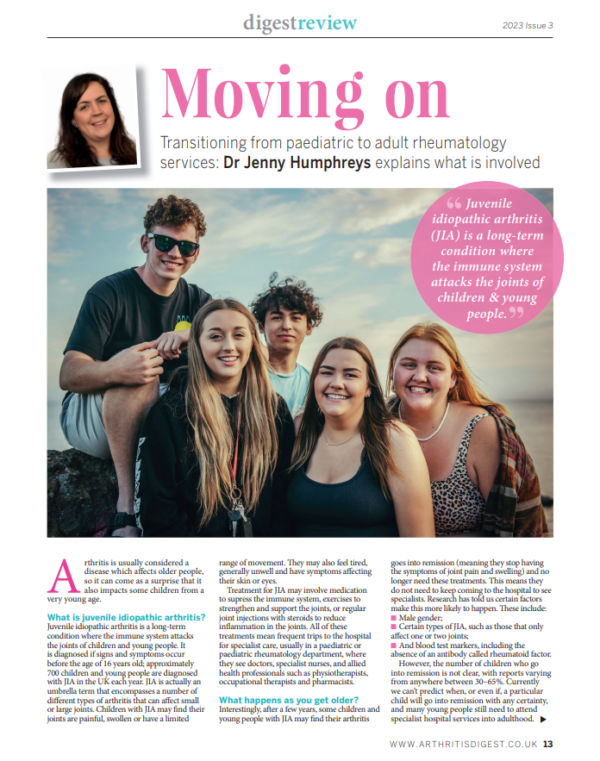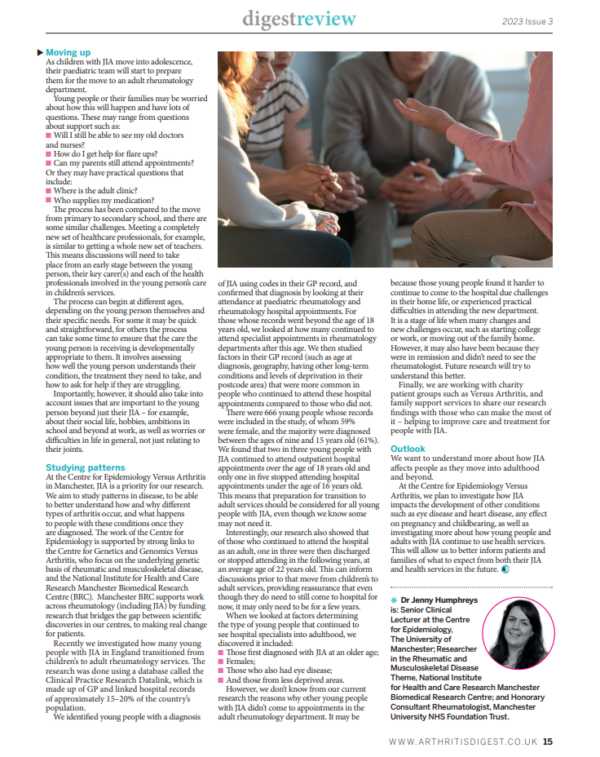Transitioning from paediatric to adult rheumatology services – Dr Jenny Humphreys speaks to Arthritis Digest
Arthritis Digest is a magazine for people with arthritis that highlights the latest relevant research and reviews topical issues.
Dr Jenny Humphreys is Senior Clinical Lecturer at the Centre for Epidemiology Versus Arthritis at The University of Manchester, Researcher in Manchester Biomedical Research Centre’s Rheumatic and Musculoskeletal Disease Theme, and Honorary Consultant Rheumatologist at Manchester University NHS Foundation Trust. Continuing regular contributions from our researchers, she explains what is involved during the transition from paediatric to adult rheumatology services for people with juvenile idiopathic arthritis.
Arthritis is usually considered a disease which affects older people, so it can come as a surprise that it also impacts some children from a very young age.
What is juvenile idiopathic arthritis?
Juvenile idiopathic arthritis is a long-term condition where the immune system attacks the joints of children and young people. It is diagnosed if signs and symptoms occur before the age of 16 years old; approximately 700 children and young people are diagnosed with JIA in the UK each year.
JIA is actually an umbrella term that encompasses a number of different types of arthritis that can affect small or large joints. Children with JIA may find their joints are painful, swollen or have a limited range of movement. They may also feel tired, generally unwell and have symptoms affecting their skin or eyes.

Treatment for JIA may involve medication to supress the immune system, exercises to strengthen and support the joints, or regular joint injections with steroids to reduce inflammation in the joints. All of these treatments mean frequent trips to the hospital for specialist care, usually in a paediatric or paediatric rheumatology department, where they see doctors, specialist nurses, and allied health professionals such as physiotherapists, occupational therapists and pharmacists.
What happens as you get older?
Interestingly, after a few years, some children and young people with JIA may find their arthritis goes into remission (meaning they stop having the symptoms of joint pain and swelling) and no longer need these treatments. This means they do not need to keep coming to the hospital to see specialists. Research has told us certain factors make this more likely to happen. These include:
- Male gender
- Certain types of JIA, such as those that only affect one or two joints
- And blood test markers, including the absence of an antibody called rheumatoid factor.
However, the number of children who go into remission is not clear, with reports* varying from anywhere between 30–65%. Currently we can’t predict when, or even if, a particular child will go into remission with any certainty, and many young people still need to attend specialist hospital services into adulthood.
Moving up
As children with JIA move into adolescence, their paediatric team will start to prepare them for the move to an adult rheumatology department.
Young people or their families may be worried about how this will happen and have lots of questions. These may range from questions about support such as:
- Will I still be able to see my old doctors and nurses?
- How do I get help for flare ups?
- Can my parents still attend appointments?
Or they may have practical questions that include:
- Where is the adult clinic?
- Who supplies my medication?

The process has been compared to the move from primary to secondary school, and there are some similar challenges. Meeting a completely new set of healthcare professionals, for example, is similar to getting a whole new set of teachers. This means discussions will need to take place from an early stage between the young person, their key carer(s) and each of the health professionals involved in the young person’s care in children’s services.
The process can begin at different ages, depending on the young person themselves and their specific needs. For some it may be quick and straightforward, for others the process can take some time to ensure that the care the young person is receiving is developmentally appropriate to them. It involves assessing how well the young person understands their condition, the treatment they need to take, and how to ask for help if they are struggling.
Importantly, however, it should also take into account issues that are important to the young person beyond just their JIA – for example, about their social life, hobbies, ambitions in school and beyond at work, as well as worries or difficulties in life in general, not just relating to their joints.
Studying patterns
At the Centre for Epidemiology Versus Arthritis in Manchester, JIA is a priority for our research. We aim to study patterns in disease, to be able to better understand how and why different types of arthritis occur, and what happens to people with these conditions once they are diagnosed. The work of the Centre for Epidemiology is supported by strong links to the Centre for Genetics and Genomics Versus Arthritis, who focus on the underlying genetic basis of rheumatic and musculoskeletal disease, and the National Institute for Health and Care Research Manchester Biomedical Research Centre (BRC).
Manchester BRC supports work across rheumatology (including JIA) by funding research that bridges the gap between scientific discoveries in our centres, to making real change for patients.
Recently we investigated how many young people with JIA in England transitioned from children’s to adult rheumatology services. The research was done using a database called the Clinical Practice Research Datalink, which is made up of GP and linked hospital records of approximately 15–20% of the country’s population.
We identified young people with a diagnosis of JIA using codes in their GP record, and confirmed that diagnosis by looking at their attendance at paediatric rheumatology and rheumatology hospital appointments. For those whose records went beyond the age of 18 years old, we looked at how many continued to attend specialist appointments in rheumatology departments after this age.
We then studied factors in their GP record (such as age at diagnosis, geography, having other long-term conditions and levels of deprivation in their postcode area) that were more common in people who continued to attend these hospital appointments compared to those who did not.
There were 666 young people whose records were included in the study, of whom 59% were female, and the majority were diagnosed between the ages of nine and 15 years old (61%). We found that two in three young people with JIA continued to attend outpatient hospital appointments over the age of 18 years old and only one in five stopped attending hospital appointments under the age of 16 years old. This means that preparation for transition to adult services should be considered for all young people with JIA, even though we know some may not need it.

Interestingly, our research also showed that of those who continued to attend the hospital as an adult, one in three were then discharged or stopped attending in the following years, at an average age of 22 years old. This can inform discussions prior to that move from children’s to adult services, providing reassurance that even though they do need to still come to hospital for now, it may only need to be for a few years.
When we looked at factors determining the type of young people that continued to see hospital specialists into adulthood, we discovered it included:
- Those first diagnosed with JIA at an older age;
- Females;
- Those who also had eye disease;
- And those from less deprived areas.
However, we don’t know from our current research the reasons why other young people with JIA didn’t come to appointments in the adult rheumatology department. It may be because those young people found it harder to continue to come to the hospital due challenges in their home life, or experienced practical difficulties in attending the new department. It is a stage of life when many changes and new challenges occur, such as starting college or work, or moving out of the family home. However, it may also have been because they were in remission and didn’t need to see the rheumatologist. Future research will try to understand this better.
We are working with charity patient groups such as Versus Arthritis, and family support services to share our research findings with those who can make the most of it – helping to improve care and treatment for people with JIA.
Outlook
We want to understand more about how JIA affects people as they move into adulthood and beyond. At the Centre for Epidemiology Versus Arthritis, we plan to investigate how JIA impacts the development of other conditions such as eye disease and heart disease, any effect on pregnancy and childbearing, as well as investigating more about how young people and adults with JIA continue to use health services. This will allow us to better inform patients and families of what to expect from both their JIA and health services in the future.
*Selvaag AM, Aulie HA, Lilleby V, Flatø B. Disease progression into adulthood and predictors of long-term active disease in juvenile idiopathic arthritis
Chhabra A, Robinson C, Houghton K, Cabral DA, Morishita K, Tucker LB, Petty RE, Larché M, Batthish M, and Guzmank J. Long-term outcomes and disease course of children with juvenile idiopathic arthritis in the ReACCh-Out cohort: a two-centre experience
Shoop-Worrall SJW, Kearsley-Fleet L, Thomson W, Verstappen SMM, Hyrich KL. How common is remission in juvenile idiopathic arthritis: A systematic review